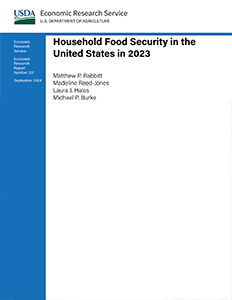Household Food Security in the United States in 2023
- by Matthew P. Rabbitt, Madeline Reed-Jones, Laura J. Hales and Michael P. Burke
- 9/4/2024
Overview
An estimated 86.5 percent of U.S. households were food secure throughout the entire year in 2023, with access at all times to enough food for an active, healthy life for all household members. The remaining households (13.5 percent, statistically significantly higher than the 12.8 percent in 2022) were food insecure at least some time during the year. Very low food security is the more severe range of food insecurity where one or more household members experience reduced food intake and disrupted eating patterns at times during the year because of limited money or other resources for food. In 2023, 5.1 percent of households were very low food secure, an estimate that is statistically similar to the 5.1 percent in 2022.
See related tables: Statistical Supplement to Household Food Security in the United States in 2023
How to Cite:
Rabbitt, M. P., Reed-Jones, M., Hales, L. J., & Burke, M. P. (2024). Household food security in the United States in 2023 (Report No. ERR-337). U.S. Department of Agriculture, Economic Research Service. https://doi.org/10.32747/2024.8583175.ers
Download
-
Entire report
Download PDF -
Report summary
Download PDF

